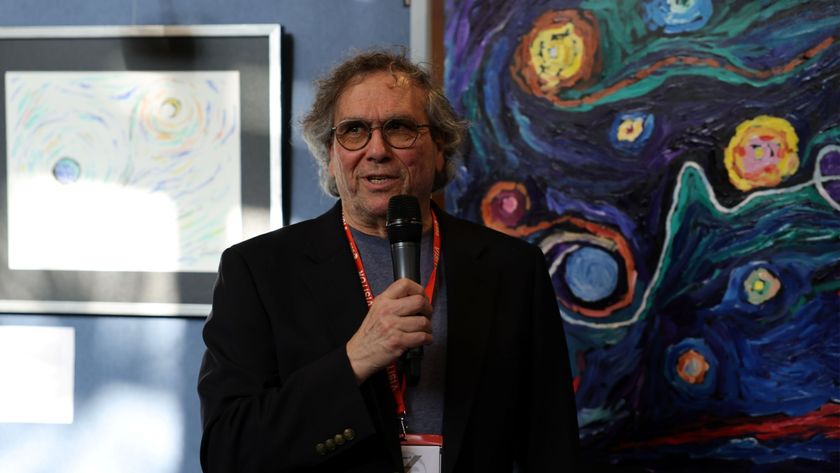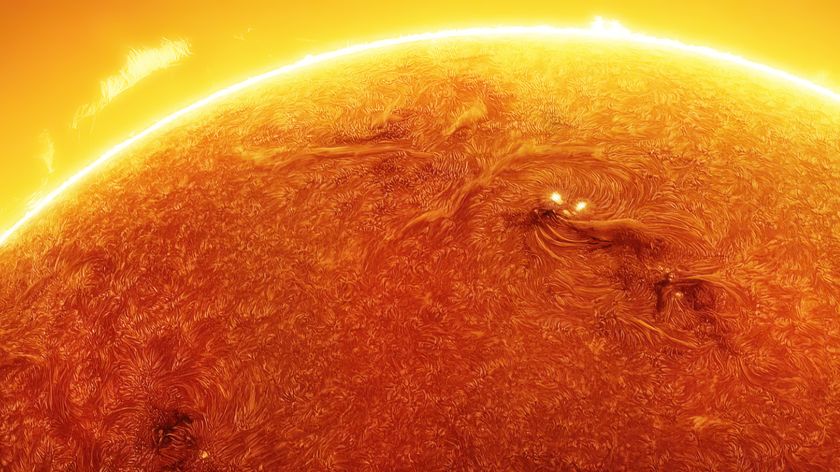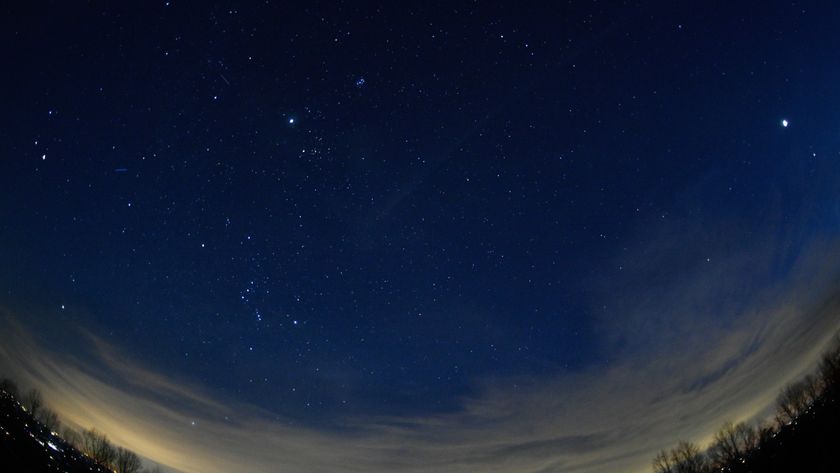Elon Musk Unveils SpaceX's New Starship Plans for Private Trips to the Moon, Mars and Beyond
People could start flying aboard the vehicle in the next year or so, Musk said.

BOCA CHICA, Texas — Elon Musk has a Starship, and one day he expects it will help SpaceX reach other worlds.
Standing beneath a towering Starship Mk1, a prototype for SpaceX's massive reusable launch system, Musk laid out his plan for interplanetary travel at the company's South Texas test site here on Saturday (Sept. 28) — the 11th anniversary of the first successful orbital launch of SpaceX's first rocket, the Falcon 1.
The new version of Starship (and its Super Heavy booster) will be able to carry up to 100 people to the moon, Mars or other destinations in space or around Earth, he said. It will stand 387 feet (118 meters) tall and be completely reusable, with quick turnarounds.
This is the rocket that will launch the billionaire Japanese entrepreneur Yusaku Maezawa and a handful of artists on a trip around the moon in the 2020s. SpaceX unveiled that planned space tourist trip last year (but did not disclose how much Maezawa paid).
"This is, I think, the most inspiring thing I have ever seen," Musk told a crowd of about 200 SpaceX employees, guests and reporters at the company's site near Boca Chica Village, just outside of Brownsville. "Wow, what an incredible job by such a great team to build this incredible vehicle. I'm so proud to work with such a great team."
Musk later thanked Maezawa for his support. The billionaire has contributed an unspecified amount to SpaceX to aid Starship's development.
Related: SpaceX's Starship and Super Heavy Mars Rocket in Pictures
Get the Space.com Newsletter
Breaking space news, the latest updates on rocket launches, skywatching events and more!
Musk has long said that the main goal of SpaceX, since its founding in 2002, has been to help make humanity a multiplanet species. The company has developed reusable Falcon 9 and Falcon Heavy rockets, as well as reusable Dragon cargo capsules and a new Crew Dragon ship for astronauts. It has launchpads in Florida, California and now Boca Chica, where the company broke ground on its test site in 2014.
But Mars, Musk has said, has remained the true objective.
"This is the fastest path to a self-sustaining city on Mars," he said Saturday night, referring to the Starship-Super Heavy architecture.
A Starship evolution
SpaceX's Starship concept has undergone a kind of rocket evolution in the three years since Musk first unveiled it to the world in September 2016 at the International Astronautical Union meeting in Mexico.
At that meeting, Musk unveiled what he called the the Interplanetary Transport System, or ITS, for Mars colonization. The ITS called for a fully reusable spacecraft (with two fins) and booster that would stand 400 feet (122 m) high when assembled. Its first stage would have 42 next-generation Raptor engines, and the booster would be 40 feet (12 m) wide. The spacecraft would have nine Raptors. (SpaceX's Falcon 9 rockets have nine Merlin engines on their first stage. Falcon Heavy first stages have 27 Merlins.)
Musk updated the design in 2017, calling it the Big Falcon Rocket, or BFR for short. That plan called for a launch system that would stand 348 feet (106 meters) tall and 30 feet (9 m) wide. Its booster would have 31 Raptor engines, while the spacecraft atop it would have six.
Then, in 2018, Musk unveiled yet another design (and the Starship name): a sleek, stainless-steel spacecraft with three tail fins that would stand taller than its 2017 precursor, with a height of 387 feet (118 m). The spacecraft would still be powered by six Raptor engines, with up to 37 Raptors powering the booster (now called Super Heavy).
The switch to 301 stainless steel from a lightweight, but expensive, carbon fiber composite material, was a turning point, Musk said. The steel gets stronger the colder it gets, making it perfect for flights in the cold depths of space. It also has a higher melting point, making it more resilient during the fiery reentry through Earth's atmosphere.
It's also way cheaper, about 2% the cost of carbon fiber, he added.
"Steel was the best design decision on this whole thing," Musk said.
This latest design has held to the present day; SpaceX is still shooting for a 387-foot-tall Starship-Super Heavy stack, with six Raptors on the spacecraft. The number of engines on Super Heavy could vary from flight to flight; Musk said the rocket has space for up to 37 Raptors, and each mission will probably require at least 24.
"Starship will allow us to inhabit other worlds," Musk wrote on Twitter Friday (Sept. 27). "To make life as we know it interplanetary."
With the design nailed down, SpaceX plans to move fast.
"This is going to sound totally nuts but I think we want to try to reach orbit in less than six months," Musk said. "Provided the rate of design improvement and manufacturing improvement continues to be exponential, I think that is accurate to within a few months."
.And people could start flying aboard the vehicle in the next year or so if the test program continues to go well, he added. That appears to be an extremely accelerated program, given that SpaceX has not yet launched astronauts on its Crew Dragon spacecraft for NASA.
A city's hope, but with critics
While Musk and SpaceX have been lauded by their ambitious push for a Starship capable of deep-space travel, the road has not always been smooth.
As the company ramped up its testing with a smaller rocket, called Starhopper, frequent road closures, launch hazard advisories and other side effects of the program sparked ire among some residents of Boca Chica Village, a nearby beachside community. SpaceX's Starship Mk1, for example, is just dozens of feet from a main travel route, Boca Chica Boulevard, that leads to the village.
Earlier on Saturday, the boulevard was the scene of a rotating gallery of onlookers and SpaceX fans posing for selfies and photos with the Starship Mk1, even as SpaceX put the finishing touches on the 165-foot (50 m) vehicle.
"I can sum up my first impression like this: 'Ooo, Shiny!'" said Roy Paul, 78, of Mebane, North Carolina, who flew to Houston and drove over 7 hours with a niece, nephew and their five children from Beaumont to see the Starship Mk1. He's a dedicated space fan who goes as IonMars on NASASpaceflight.com forums.
This month, SpaceX offered to buy out some Boca Chica Village residents after a short 500-foot (150 m) test sparked a brush fire at the test site, according to Business Insider.
On Saturday, Musk confirmed that SpaceX has sought to buy out some Boca Chica residents. If SpaceX's flight test rate holds, then Starship launches may become more disruptive to the hamlet's residents, he said.
Then there are SpaceX's other customers.
NASA is still waiting for SpaceX to complete the Crew Dragon spacecraft that will fly astronauts to and from the International Space Station. The space agency has picked SpaceX (and another company, Boeing) to provide commercial crew flights to the station.
While SpaceX did launch an unpiloted Crew Dragon test flight to the space station this year, a subsequent abort system test failed, leading to the destruction of the vehicle. SpaceX aims to resume abort system tests later this year ahead of the first crewed test flight.
NASA Administrator Jim Bridenstine, it seems, is not happy with the years-long delays of Crew Dragon, as well as Boeing's Starliner spacecraft, especially after seeing SpaceX build Starship Mk1 this year ahead of its own test flight.
"I am looking forward to the SpaceX announcement tomorrow," Bridenstine wrote on Twitter Friday. "In the meantime, Commercial Crew is years behind schedule. NASA expects to see the same level of enthusiasm focused on the investments of the taxpayer. It's time to deliver."
On Saturday night, Musk assured that SpaceX is focused on Crew Dragon for NASA, as well as flights for other customers. Only about 5% of SpaceX's resources are devoted to the Starship program, he said.
Meanwhile, the city of Brownsville, remains hopeful that SpaceX's presence — and future launches from Boca Chica — could be a boon for the community.
The city's mayor, Trey Mendez, a lawyer and native of Brownsville, said that in the five years SpaceX has been at the Boca Chica site, the area has seen some tourists come to gawk at the rockets, but such visits have not had a significant impact on the city's economy.
That could change, Mendez said, if SpaceX sets up regular space launches from Boca Chica. But if the area just stays a test site, then it may not be as big an impact as the city would like.
"Definitely I can say that the community is overall excited with the opportunities that the space industry brings. And we're excited to learn more about SpaceX's plans out here," Mendez told Space.com just hours before Musk's presentation. "I certainly hope that it is something that will have a measurable impact for our city, because I would definitely love to have that."
- Elon Musk: Revolutionary Private Space Entrepreneur
- See the Evolution of SpaceX's Rockets in Pictures
- SpaceX: First Private Flights to Space Station
Space.com Senior Space Writer Mike Wall contributed to this story. This story has been updated to include new comments by Elon Musk from his Starship update.
Email Tariq Malik at tmalik@space.com or follow him @tariqjmalik. Follow us @Spacedotcom and Facebook.

Join our Space Forums to keep talking space on the latest missions, night sky and more! And if you have a news tip, correction or comment, let us know at: community@space.com.

Tariq is the Editor-in-Chief of Space.com and joined the team in 2001, first as an intern and staff writer, and later as an editor. He covers human spaceflight, exploration and space science, as well as skywatching and entertainment. He became Space.com's Managing Editor in 2009 and Editor-in-Chief in 2019. Before joining Space.com, Tariq was a staff reporter for The Los Angeles Times covering education and city beats in La Habra, Fullerton and Huntington Beach. In October 2022, Tariq received the Harry Kolcum Award for excellence in space reporting from the National Space Club Florida Committee. He is also an Eagle Scout (yes, he has the Space Exploration merit badge) and went to Space Camp four times as a kid and a fifth time as an adult. He has journalism degrees from the University of Southern California and New York University. You can find Tariq at Space.com and as the co-host to the This Week In Space podcast with space historian Rod Pyle on the TWiT network. To see his latest project, you can follow Tariq on Twitter @tariqjmalik.











